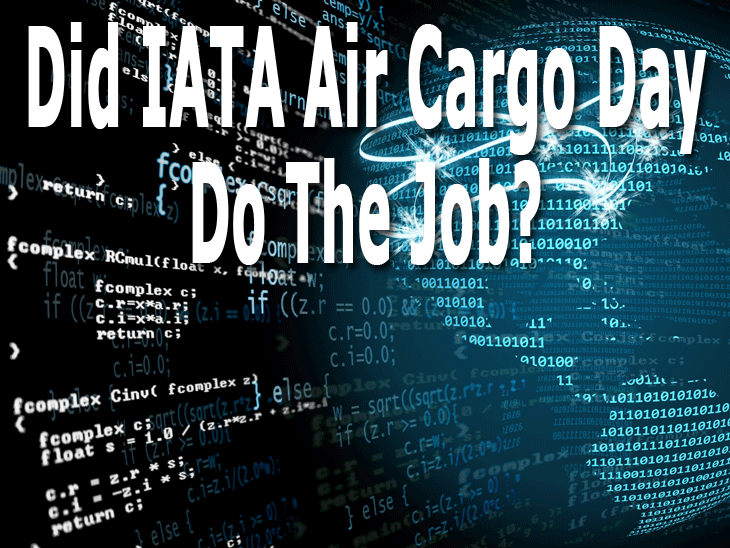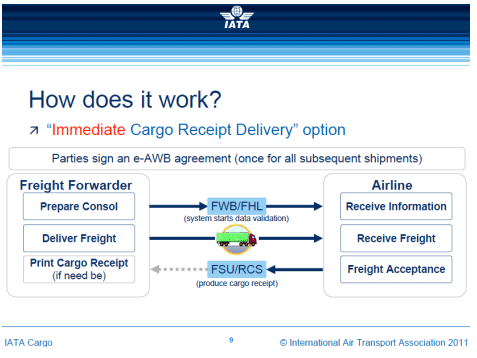Did
IATA Air Cargo Day Work?
Although others are rapturous and some
may not have a clue, a closer look at the recent IATA Cargo Day had
a mix of the usual themes and some new wrinkles. With IATA, it’s
a bit like motherhood and apple pie – what is there not to like?
It is useful to put some things in perspective.
For example, the IATA/WCO agreements; they have been around long enough
to have grown gray beards by now. The principle has been a laudable
one—adopt and promote a common standard, and all sides benefit.
Then, if an airline happens to operate in the EU, US and Pacific Asia,
it turns out that the reality is rather different. Despite governments
having signed these agreements, when it’s their turn to implement
a customs system, all bets are off and the airline ends up needing unique
interfaces for the various customs systems. Why? Apparently, because
they can.
Ironically, the WCO website still carries
a 2009 announcement, including the intent that “by the end of
2009, the project plans to replace 16 documents with IATA and WCO electronic
messages and by the end of 2010, 20 documents will be supported by an
electronic standard, constituting approximately 64 percent of the paper
volume.” No update and nothing new since that time. You may draw
your own conclusions. It so happens there is a problem with some minor
players—China, India, Russia, just to name a few.
Let’s not forget that WCO is the
same organization airlines look to for harmonizing global air cargo
security measures. Regrettably, the precedent and history are not encouraging,
despite critical times for the world economy. It’s never about
the words; the language is invariably forceful and demonstrative of
a strong commitment. WCO works with ICAO and earlier this year, it was
communicated that “together … will carry out a review of
its existing procedures through a newly-constituted Technical Experts
Group on Air Cargo Security. They will analyze such vital issues as
electronic advance data, the sharing of information at various levels
(government-to-government, Customs-to-Customs, and Customs-to-industry)
and risk management.” Swell; just please be careful not to step
over those TSA and CBP folks in 92-plus countries out of the 190 ICAO
‘member states,’ the EU, IATA, FIATA and GACAG.
It will undoubtedly get done; the only
question is when and, clearly, one can’t rush these matters enough.
It has been said that it takes Apple 6-9 months to come out with a new
product, but that’s an unfair analogy, right?
 It’s
much more straightforward to instead talk about something more concrete
that forwarders and airlines understand—the air waybill. Unless
one lives under a rock, e-freight and e-AWB have flooded the senses
enough times that it surely has registered. Again, it’s a concept
with which no one can find fault. The only trouble both starts with
and depends on the one thing the industry has struggled with mightily
for over 20 years. A picture is worth a thousand words, as illustrated
here: It’s
much more straightforward to instead talk about something more concrete
that forwarders and airlines understand—the air waybill. Unless
one lives under a rock, e-freight and e-AWB have flooded the senses
enough times that it surely has registered. Again, it’s a concept
with which no one can find fault. The only trouble both starts with
and depends on the one thing the industry has struggled with mightily
for over 20 years. A picture is worth a thousand words, as illustrated
here:
Yes, you guessed it! It’s the forwarder
starting the entire information chain by sending a FWB message. E-AWB
will be mandatory for e-freight in 2013 and IATA is aiming for 100 percent
e-freight by 2015. It’s all about the process, which requires
“the capability to send, receive & archive FWB, FSU/RCS, FSU/FOH
messages…”
It is clear that something of this magnitude
and scope needs relentless marketing and communications to make sure
the message is loud and clear. And yet, while this global effort has
been underway, there are a number of challenges with the fundamentals
and those pesky details, and there hasn’t been anywhere near the
focus and effort on these underpinnings, which are perhaps taken for
granted. By the way, don’t necessarily just listen to the executives
in charge; try instead the cargo IT hands-on people if you want to know
the facts, as they are day-in-and-day-out on the ground.
The FWB – in a recent side bar discussion
among folks with a minimum of 30 years background in these matters,
here is what came out as needing to be addressed pronto: the Cargo-IMP
does not contain provisions regarding two opposing scenarios—1)
the forwarder sending no FWB, and 2) the forwarder sending multiple
FWB for one shipment. Just as how prior to Cargo2000 and CDMP, airlines
tweaked FWB to uniquely suit their needs, requiring specific information
in a certain field, currently airlines have different policies regarding
multiple FWB. There is no industry standard for updating a FWB once,
twice, three times, at what intervals, nor explicitly prohibiting more
than one FWB per shipment. Nor is there a cancelation message or any
means to reissue a message.
There is more; data quality, which becomes
particularly critical as e-AWB volume grows. Some examples: one or more
dots (.) in the shipper or consignee fields, 5 zeros in US ZIP codes,
or country names in the town field. The vaunted CDMP does not handle
business rules. Going back to the topic of Customs, for example, U.S.
Customs requires a ZIP code—what to do? Changes to a forwarder-issued
air waybill by the airline require a CCA (Charges Correction Advise),
but it is inconceivable to automate the CCA process in this environment.
Using CCA may actually be used, or abused, as a work around, rather
than solving the correct FWB transmittal.
This is not a new issue by any means,
yet it is one that needs urgent attention and resolution before the
galloping e-freight train. Airlines have been so keen and frustrated
in their long quest for forwarder-generated FWB that it has resulted
in a regime of extreme flexibility, which is in practice proving to
be detrimental in a paperless environment.
Airlines and forwarders are discussing
these matters and they arise on and off with IATA. More needs to be
done if this is to succeed and there must be a new approach to induce
and incentivize participants in e-AWB and e-freight are to definitely
have a FWB sent in the first place, but also to make the practice of
making changes to FWB a thing of the past. One effective way would be
to impose financial consequence; that resonates in every language. Somehow
I can’t help but suspect there will be more on this topic.
Ted Braun |



